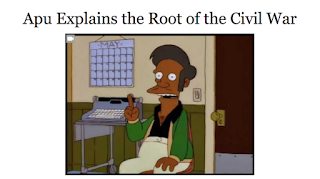Last week was our first week of school and our students wanted to know what had happened in Charlottesville, VA the previous weekend. As a US history teacher, I helped my students discuss what had happened. However, over the weekend, when things calmed down, I put together a Google Presentation with a wide ranging bibliography to give a clearer view of what happened.
As most everyone has heard by now, last weekend a protest and a counter protest were held in Charlottesville, VA near the campus of the University of Virginia and a protester was killed while a couple of Virginia State Troopers were killed in a helicopter crash while responding to the clash of the different groups.
Why did all of this happen?
The bottom line is slavery and the Civil War and the culture of the former Confederacy in the years since the Civil War. If our students can understand these issues, we can help them understand what happened last week.
In order to get a fuller picture, I put together a bibliography with a number of different perspectives regarding slavery, the Lost Cause, and Jim Crow to give my students a better understanding of why people were protesting the potential removal of an old statue.
I got started with an article by Matthew Green of KQED's The Lowdown, which gave a clear overview of the issues and from which I got some of the visuals for my presentation. There is also a link to a solid overview on the events of Friday night, August 11 and Saturday morning, August 12 from NPR.
From there I found a list of slaveowning presidents in US history to give some background as to the pervasiveness of slavery among the nation's founding leaders and to also put Robert E. Lee and other Confederate leaders in context.
However, the presentation begins with a YouTube video of a clip from the Simpsons, where the character Apu is taking his citizenship test and comes up against the final question on the cause of the Civil War. The clip allows us to realize that the bottom line of the Civil War was slavery and from there it gets complicated, but without slavery, there would never have been such a horrible conflagration let alone secession.
This is key as one of the main tenets of the argument for Confederate symbols and monuments is that these icons do not celebrate slavery but more celebrate the honor of the soldiers who fought in the Civil War on the side of the Confederacy. The best evidence to give lie to this line of thinking is the declarations that the seceding states used to leave the Union. Slavery was fundamental to their motivations to break up the United States. We will use the Mississippi declaration.
In order to understand how these ideas gained some currency, we need to help our students understand the Lost Cause and Jim Crow. I try to get my students to understand why former Confederates were motivated to justify their roles in the Civil War and then they have to understand the rise and prevalence of Jim Crow.
From there I need my California students to understand that these ideas were not solely confined to the South and we take a look at some examples of Confederate monuments in the Central Valley and Los Angeles.
The last two slides are on President Trump's response to Charlottesville and the presence of Nazi flags to shine light on some of the other issues that have cropped up after and during the protests themselves. The Trump slide gives us an opportunity to discuss what are the major issues involved in how we look at history and allows us to contrast Confederate leaders and the early presidents of the United States. Should we view the slaveowning presidents in the same light as the Confederate leaders? If so, why? If not, why not? From there we can discuss how and why Confederate leaders played a role in secession and contrast that against the role that the slaveowning presidents played in building the Union.
How do we discuss the presence of swastikas at a rally that purportedly was designed to celebrate Southern culture and honor? From my perspective as a US history teacher as well as a student of modern European history, I can say that the protesters who allowed swastikas among them lost any moral standing and the rally could not have been for Southern honor and culture with the presence of an unquestionably White Supremacist symbol.
Finally, I have included a list of 10 questions to help my students focus on the main issues from the presentation and provides us a number of places to stop and discuss what happened.
If we can help our students understand these issues, we will understand much better how these issues have grown and will continue to plague our country if we don't deal with them clearly and stop letting them fester and grow in strength.
Learning is my business. What do you think?







Nice and interesting post
ReplyDeleteSocial Network For Business
Social Network Marketing